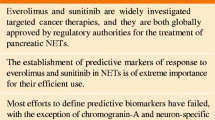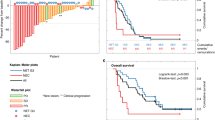Summary
Objectives Several targeted therapies are available for metastatic neuroendocrine tumours (NETs) but no predictive factor of response to these treatments has been identified yet. Our aim was to identify and evaluate clinical, biological, histological and functional markers of response to everolimus. Methods We retrospectively reviewed 53 patients with NETs treated with everolimus (68 % in clinical trials). Clinical, biological and histological data were analyzed. The functional marker p-p70S6K, a main effector of the mTOR pathway, was studied by immunohistochemistry in 43 cases. Prognostic factors of progression-free survival (PFS) were studied by Kaplan Meier analysis. Results All patients had metastatic and progressive disease before everolimus treatment. Objective response was 9 % and median PFS was 8.1 (4.7–11.5) months. Hypercholesterolemia (HR = 0.13, p < 0.0001) was associated with longer PFS, whereas presence of bone metastases (HR = 3.1, p < 0.001) and overexpression of p-p70S6K by tumor cells (HR = 2.5, p = 0.01) were associated with shorter PFS under everolimus at multivariate analysis. Conclusion Clinical markers are not useful to predict response to everolimus. However, occurrence of hypercholesterolemia under treatment may be an early marker of response. Prospective studies are required to confirm these results and to assess whether p-p70S6K immunostaining is a prognostic or predictive marker of no-response to everolimus.


Similar content being viewed by others
References
Yao JC, Hassan M, Phan A, et al. (2008) One hundred years after “carcinoid”: epidemiology of and prognostic factors for neuroendocrine tumors in 35, 825 cases in the United States. J Clin Oncol Off J Am Soc Clin Oncol 26:3063–3072
Pavel ME, Hainsworth JD, Baudin E, et al. (2011) Everolimus plus octreotide long-acting repeatable for the treatment of advanced neuroendocrine tumours associated with carcinoid syndrome (RADIANT-2): a randomised, placebo-controlled, phase 3 study. Lancet 378:2005–2012
Yao JC, Fazio N, Singh S et al. (2016) Everolimus for the treatment of advanced, non-functional neuroendocrine tumours of the lung or gastrointestinal tract (RADIANT-4): a randomised, placebo-controlled, phase 3 study. Lancet 387(10022):968–77. doi: 10.1016/S0140-6736(15)00817-X.
Yao JC, Shah MH, Ito T, et al. (2011) Everolimus for advanced pancreatic neuroendocrine tumors. N Engl J Med 364:514–523
Galanis E, Buckner JC, Maurer MJ, et al. (2005) Phase II trial of temsirolimus (CCI-779) in recurrent glioblastoma multiforme: a north central cancer treatment group study. J Clin Oncol Off J Am Soc Clin Oncol 23:5294–5304
Lee CK, Marschner IC, Simes RJ, et al. (2012) Increase in cholesterol predicts survival advantage in renal cell carcinoma patients treated with temsirolimus. Clin Cancer Res: An Official Journal of the American Association for Cancer Research 18:3188–3196
Ravaud A, Urva SR, Grosch K, et al. (2014) Relationship between everolimus exposure and safety and efficacy: meta-analysis of clinical trials in oncology. Eur J Cancer 50:486–495
Neshat MS, Mellinghoff IK, Tran C, et al. (2001) Enhanced sensitivity of PTEN-deficient tumors to inhibition of FRAP/mTOR. Proc Natl Acad Sci U S A 98:10314–10319
Janku F, Wheler JJ, Westin SN, et al. (2012) PI3K/AKT/mTOR inhibitors in patients with breast and gynecologic malignancies harboring PIK3CA mutations. J Clin Oncol Off J Am Soc Clin Oncol 30:777–782
Iyer G, Hanrahan AJ, Milowsky MI, et al. (2012) Genome sequencing identifies a basis for everolimus sensitivity. Science 338:221
Bollard J, Couderc C, Blanc M, et al. (2013) Antitumor effect of everolimus in preclinical models of high-grade gastroenteropancreatic neuroendocrine carcinomas. Neuroendocrinology 97:331–340
Cho D, Signoretti S, Dabora S, et al. (2007) Potential histologic and molecular predictors of response to temsirolimus in patients with advanced renal cell carcinoma. Clin Genitourin Cancer 5:379–385
Duran I, Kortmansky J, Singh D, et al. (2006) A phase II clinical and pharmacodynamic study of temsirolimus in advanced neuroendocrine carcinomas. Br J Cancer 95:1148–1154
Yoon DH, Ryu MH, Park YS, et al. (2012) Phase II study of everolimus with biomarker exploration in patients with advanced gastric cancer refractory to chemotherapy including fluoropyrimidine and platinum. Br J Cancer 106:1039–1044
Lombard-Bohas C, Cariou B, Verges B, et al. (2014) Management of metabolic disorders induced by everolimus in patients with differentiated neuroendocrine tumors: expert proposals. Bull Cancer 101:175–183
Verges B, Walter T, Cariou B (2014) ENDOCRINE SIDE EFFECTS OF ANTI-CANCER DRUGS effects of anti-cancer targeted therapies on lipid and glucose metabolism. Eur J Endocrinol 170:R43–R55
Bilimoria KY, Talamonti MS, Tomlinson JS, et al. (2008) Prognostic score predicting survival after resection of pancreatic neuroendocrine tumors: analysis of 3851 patients. Ann Surg 247:490–500
Khan MS, Kirkwood A, Tsigani T, et al. (2013) Circulating tumor cells as prognostic markers in neuroendocrine tumors. J Clin Oncol Off J Am Soc Clin Oncol 31:365–372
Capurso G, Archibugi L, Delle Fave G (2015) Molecular pathogenesis and targeted therapy of sporadic pancreatic neuroendocrine tumors. J Hepatobiliary Pancreat Sci 22(8):594–601. doi:10.1002/jhbp.210.
Missiaglia E, Dalai I, Barbi S, et al. (2009) Pancreatic endocrine tumors: expression profiling evidences a role for AKT-mTOR pathway. J Clin Oncol Off J Am Soc Clin Oncol 28:245–255
Qian ZR, Ter-Minassian M, Chan JA, et al. (2013) Prognostic significance of MTOR pathway component expression in neuroendocrine tumors. J Clin Oncol Off J Am Soc Clin Oncol 31:3418–3425
Sharpe LJ, Brown AJ (2008) Rapamycin down-regulates LDL-receptor expression independently of SREBP-2. Biochem Biophys Res Commun 373:670–674
Custodio AJ-FP, Alonso-Orduña V, López López C, Alonso T, Guillermo C, Carmona-Bayonas A, Álvarez-Escolá CSM, Capdevila J, Grande E, Barriuso J, Feliu J, Aller J (2015) Everolimus (EVE)-induced hyperglycemia (HG) in patients (pts) with advanced G1-G2 neuroendocrine tumors (NETs): clinical relevance and predictive value. ENETS - The European Neuroendocrine Tumor Society. Barcelona, In
Rugo HS, Hortobagyi GN, Yao J, Pavel M, Ravaud A, Franz D, Ringeisen F, Gallo J, Rouyrre N, Anak O, Motzer R (2016) Meta-analysis of stomatitis in clinical studies of everolimus: incidence and relationship with efficacy. Ann Oncol 27(3):519–525. doi:10.1093/annonc/mdv595.
Templeton AJ, Dutoit V, Cathomas R, et al. (2013) Phase 2 trial of single-agent everolimus in chemotherapy-naive patients with castration-resistant prostate cancer (SAKK 08/08). Eur Urol 64:150–158
Author contributions
Study design: NB, CV, CR, JYS, TW
Collection of data: NB, VH, JYS, JB, PM, TW
Writing the manuscript: NB, JYS, TW
Approval of the manuscript: all authors
Author information
Authors and Affiliations
Corresponding author
Ethics declarations
Conflict of interest
T Walter, JY Scoazec have acted as advisory board member for Ipsen, Pfizer and Novartis.
All other authors: no conflict of interest.
Funding
This study received financial support from Novartis and la Ligue Contre le Cancer du Rhône, France.
C Vercherat is recipient of a post-doctoral grant from LYric grant INCa-DGOS 4664.
Rights and permissions
About this article
Cite this article
Benslama, N., Bollard, J., Vercherat, C. et al. Prediction of response to everolimus in neuroendocrine tumors: evaluation of clinical, biological and histological factors. Invest New Drugs 34, 654–662 (2016). https://doi.org/10.1007/s10637-016-0363-6
Received:
Accepted:
Published:
Issue Date:
DOI: https://doi.org/10.1007/s10637-016-0363-6




